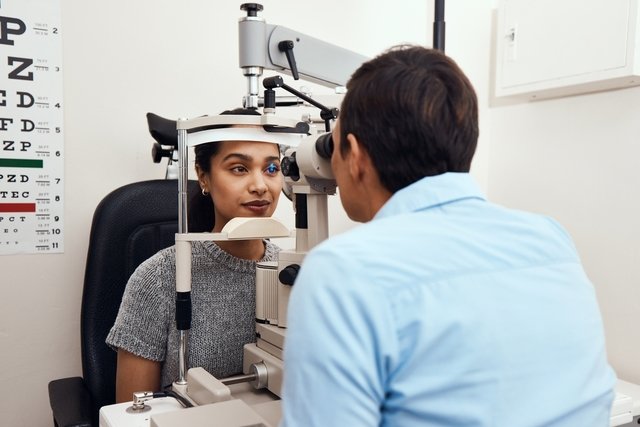Cataract surgery is a procedure in which the crystalline lens is removed, a transparent structure that works like a lens, which has an opaque stain, and is then replaced with a transparent synthetic lens, which allows vision to be restored.
This surgery can be performed using two main surgical techniques: phacoemulsification, popularly known as FACO, or extracapsular lens extraction, or EECP.
Any spot that appears on the lens is called a cataract, but the most common cataract is the so-called senile cataract, which is a consequence of the natural aging of the lens. Other causes of cataracts are genetic, congenital and metabolic factors, such as diabetes, and can occur after accidents to the head or strong blows to the eye. Understand better what cataracts are, their causes and how to identify them.

Who performs cataract surgery
The professional recommended to perform cataract surgery is an ophthalmologist, who is the doctor responsible for evaluating and guiding the treatment of diseases involving the eyes. See when it is recommended to see an ophthalmologist.
How is the surgery done
Cataract surgery can be done through:
- Phacoemulsification (FACO): In this procedure, local anesthesia is used, with anesthetic eye drops, where the person does not feel pain during the surgery. In this procedure, the crystalline lens, which has an opaque stain, is aspirated and removed, and is then replaced with a transparent foldable intraocular lens, without the need for stitches, which allows immediate recovery of vision;
- Extracapsular lens extraction (EECP): Despite being less used, this technique involves removing the entire lens manually, thus removing the stain caused by the cataract, and replacing it with a rigid or foldable transparent intraocular lens. This procedure generally requires stitches in the cornea to close the incision and the recovery process takes longer than phacoemulsification (FACO).
Cataract surgery is a procedure that can take anywhere from 20 minutes to 2 hours, depending on the technique the ophthalmologist chooses to use.
Normally, recovery from surgery lasts around 1 to 7 days, especially when the FACO or laser technique is used. But for the EECP technique, recovery can take 1 to 3 months.
What is recovery like?
During recovery, the person may feel sensitivity to light in the first few days, as well as a slight discomfort, as if there was a speck in the eye. However, these signs should always be reported to the ophthalmologist during routine consultations.
In the first week after surgery, the ophthalmologist may prescribe eye drops and, in some cases, antibiotics, and it is very important to always use these medications at the correct time, in addition to avoiding the consumption of alcohol and drugs during this period.
Care during recovery
Other important care during recovery include:
- Rest for the first day after surgery;
- Avoid swimming in the sea, swimming pool, river, lake or lagoon for 30 days;
- Avoid close-up vision activities for a long time on the first day, such as using a cell phone or computer;
- Avoid sports, risky activities and lifting weights in the first 2 weeks;
- Avoid using makeup in the first month;
- Do not sleep on the side of the operated eye in the first week;
- Protect your eyes when sleeping for the first week, using an acrylic protector.
It is still recommended to wear sunglasses whenever you go out, at least during the first few days.
Possible risks of surgery
The risks involved in cataract surgery are infection and inflammation, as well as blindness, which, although rare, can occur even when medical guidelines are followed. The most serious infection after cataract surgery is called endophthalmitis and generally occurs in 1 to 3 people out of every 10,000 patients operated on. Even with endophthalmitis, if the condition is diagnosed early, the chance of maintaining vision is great.
In cases of congenital cataracts, the risks are greater, as the child’s healing process is different from that of adults, in addition to the eye tissues being smaller and more fragile, which is a factor that makes surgery more difficult. Therefore, follow-up after surgery is essential to better stimulate the child’s vision and correct, when necessary, the prescription of the glasses.
Bibliography
- BRAZILIAN OPHTHALMOLOGY ARCHIVES. Phacoemulsification versus manual extracapsular lens extraction: cost analysis. 2004. Available at: <https://www.scielo.br/scielo.php?script=sci_arttext&pid=S0004-27492004000300021>. Accessed on October 1, 2020
- CORE . Femtosecond Laser in Cataract Surgery. 2016. Available at: <https://core.ac.uk/reader/302931760>. Accessed on October 1, 2020
- BRAZILIAN JOURNAL OF OPHTHALMOLOGY. Laser cataract surgery. 2011. Available at: <https://www.scielo.br/scielo.php?script=sci_arttext&pid=S0034-72802011000600001&lng=pt&nrm=iso>. Accessed on October 1, 2020
- CFM/AMB GUIDELINES. MINISTRY OF HEALTH. Brazilian Council of Ophthalmology . 2012. Available at: <http://www.cbo.com.br/novo/medico/pdf/Diretrizes_CBO_AMB_CFM.pdf>. Accessed on October 1, 2020
- AMC. Visual prognosis in cataract phacoemulsification surgery with intraocular lens implantation. 2005. Available at: <http://www.acm.org.br/acm/revista/pdf/artigos/283.pdf>. Accessed on October 1, 2020

Sign up for our newsletter and stay up to date with exclusive news
that can transform your routine!
Warning: Undefined array key "title" in /home/storelat/public_html/wp-content/plugins/link-whisper-premium/templates/frontend/related-posts.php on line 12
Warning: Undefined array key "title_tag" in /home/storelat/public_html/wp-content/plugins/link-whisper-premium/templates/frontend/related-posts.php on line 13



